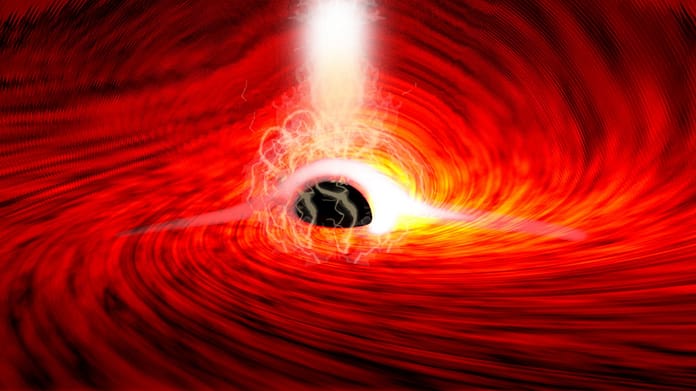
Dan Wilkins
Researchers at Stanford University first recorded X-ray images from the other side of a black hole, like this Wissensmagazin Scienexx mentioned.
In the case of black holes, due to the massive gravity, there is such a strong curvature of space-time that we can see forward and backward at the same time.
This confirms the predictions of Albert Einstein’s general theory of relativity. Notes were made in Nature Magazine chest.
Despite extensive research, black holes remain a mystery to us. We know that the mass of black holes is compressed into such a narrow space that they give off a very strong gravitational pull. Anything that enters this area will be irreversibly swallowed.
The black hole appears as a shadow in the images. In 2019, researchers were able to capture an image of a black hole for the first time. Now, about two years later, scientists at Stanford University have made another observation that tells us more about black holes. For the first time, researchers have been able to observe X-rays from the back of a black hole, as such Wissensmagazin Scienexx mentioned.
Astronomers’ observation is pioneering. It confirms a phenomenon predicted by Albert Einstein. Formulating his theory of relativity in 1915, he hypothesized that black holes – viewed from the side of a bright accretion disk made of an adsorbent – must bend spacetime. In astrophysics, an accretion disk is understood as a disk rotating around an object that moves matter toward the center. It consists of ionized gas, the so-called plasma or atomic gas. The curvature of black holes must be so strong that light must deviate from the back of the black hole and become visible from the front, according to Einstein’s assumption. This allows us to see forward and backward at the same time.

Simulations like this show what the curvature effect should look like on the side of the accretion disk.
shutterstock / o_m
Dan Wilkins, an astronomer from Stanford University, and his team have now been able to record these assumptions with the help of special X-ray telescopes. Notes were made in Nature Magazine chest. The team was able to capture radiation from the back of the black hole in the first galaxy Zwicky 1, 800 million light-years away. as such? About 60 million kilometers from the black hole, interactions between incoming plasma and magnetic fields cause strong radiation. These X-ray bursts are partially reflected by the accretion disk, and illuminated again with a slight delay.
In a later trajectory for Wilkins and his team, the researchers made further observations: the second X-ray burst appeared in terms of its spectral properties and timing as the lag of the echo of the first X-ray burst. In addition, the researchers found that the energies of individual eruptions must be reflected in different parts of the accretion disk. “Analysis of X-ray flares reveals short flashes of photons, the characteristics of which match an emission from the back of the black hole,” said Dan Wilkins. “These are particles of light that bounce off the other side of the disk and are flexed and amplified by the strong gravitational field around the black hole.”
With these observations, Einstein’s assumption can be confirmed: black holes cause such a strong curvature that both forward and backward can be seen at the same time. So the observations are another step by scientists, which brings light into darkness (black holes).
Read also
k








